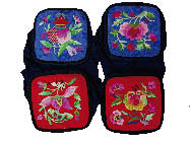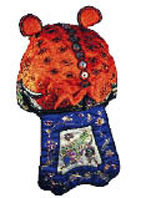|
The Birth of Feminine Art
 |
| Rural style pillow ends. | Ancient China put the desirable qualities of womanhood into four categories: morality, manner of talk, manner of behavior, and craft skills (or the work of womanhood). They were collectively known as the "Four Virtues." Initially they were compulsory lessons that all the imperial and aristocratic women had to learn and observe, but later they seeped into the ordinary family life of all women, rich and poor. As one aspect of sublime womanhood, craft skills were enhanced throughout the centuries of imperial China not only as a means of livelihood, but also a yardstick by which to measure a woman's personality and cultivation.
As women's craft skills improved, their products gained increasing artistic and aesthetic qualities, and "nügong as work" was gradually replaced by "nügong as art." Girls in ancient times began to learn "the art of nügong" from a very young age. Nü Er Jing (The Classic for Girls), a three-character rhymed folk text whose origin can be traced back to no later than the Ming Dynasty (1368-1644), advises that girls should retreat into their rooms to do needlework after getting washed in the morning, and that they became adult at the age of 11, when they should help cook for the family and spend the rest of the day in their room doing needlework.
With the help of her mother, an unmarried young woman would do needlework year after year to fill her dowry closet, which included not only her own clothes and articles of daily use but also items for her future husband, in-laws and children. Matchmakers usually presented carefully selected samples of girls' needlework to show the excellence of their womanhood to their prospective in-laws, since a skilled daughter-in-law would bring the family great honor.
As "nügong" developed into a genre of art, its products diversified and expanded to include various aspects of the feminine workmanship, such as weaving, dying, sewing, embroidery, knitting, paper-cutting, and cloth patchwork. The most widely applied and exemplary of these arts was embroidery.
Masterpieces of Womanhood
 |
| A tiger-shaped child's hat, with a drape at the back. |
Embroidery has a long history in China. Unearthed artifacts dating back more than 2,000 years speak of the highly developed craftsmanship of ancient times, as demonstrated by the elegant, curvilinear patterns done in fine and meticulous stitches of harmonious colors.
By the Song Dynasty around 1,000 years ago, stitchwork had become even more delicate and subtle, as evidenced by the following description: "Tiny and dense stitches are arrayed to close up their edges, their thread being composed of one or two silk fibers and the needle used is hair-thin." Such works of subtlety gradually emerged from embroidery done for daily use to become a highbrow ornamental art. However, these fine works were small in number. The majority of embroidered items were still folk products for daily use, done by ordinary housewives and girls.
Folk embroideries include garments, articles of daily use (such as tablecloths and bedding), and dowry and ritual items. Garments and accessories were the largest category, particularly for women and children. Embroidered patterns included auspicious animals, birds and flowers and other images that connoted happiness, fortune, peace and longevity. There were also motifs taken from folk tales and theatrical products.
Embroidered "dudou" (belly aprons) are worth a special mention as a characteristic Chinese underwear for children and adults alike. Traditional Chinese health theory believes the belly to be the most vulnerable part of the human body in terms of cold, so it needs extra protection. The aprons are diamond- or square-shaped, and have a looped lace to drape around the neck, and two laces to tie behind the waist. Those for brides are red in color, and are embroidered with patterns of lotuses, peonies, phoenixes or mandarin ducks.
A great deal of embroidery effort was also taken with pillows, as people spent more or less one-third of each day lying on them. Ancient pillows were rectangular-, or tube-shaped, their ends enclosed by square or round embroidered covers called pillow ends. Girls needed to embroider many pillow ends as part of their dowry, which would be displayed in their wedding chamber to demonstrate their fine "womanhood." There were also embroidered ear pillows — cushions with a hole in the center to accommodate the ear when one sleeps sideways.
Embroidery is widely practiced by women of minority ethnic groups as well. Miao girls start to learn embroidery with their mother at the age of four or five, and their works are mostly improvised without following any preset design. The embroidery of the Tu people on the Qinghai Plateau is also representative of an ethnic exotic "womanhood." |
